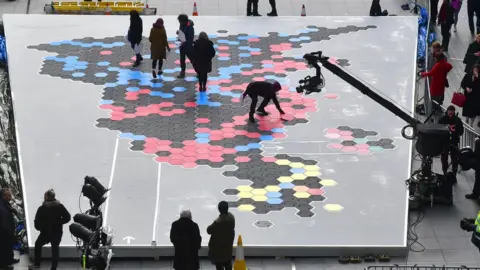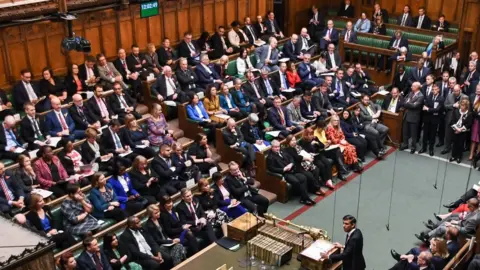Boundary review: Tories could make modest gains from new election map
 BBC
BBCThe Conservatives could gain slightly from a proposed shake-up of England's electoral map, an initial analysis suggests.
Leading experts said the party would have won an additional five seats at the last election under new draft parliamentary constituencies.
It is part of a regular redrawing of the political map to ensure seats have roughly the same number of voters.
The latest proposals were released on Tuesday, to be finalised by July 2023.
The overhaul is the first redrawing of constituency boundaries since 2010, and is set to be used at the next general election, expected in 2024.
The new boundaries, based on voter registration figures, will see England receive an additional 10 MPs, taking its total seats to 543.
Wales is due to lose eight of its current 40 seats, with the total for Scotland falling from 59 to 57. The number in Northern Ireland remains the same.
The revised seat borders come from the Boundary Commission for England, one of four independent bodies in each of the UK nations responsible for redesigning parliamentary constituencies.
Boundary commission officials are redrawing constituency boundaries to ensure between 69,724 and 77,062 people live in each one.
The latest estimate about the effect of the proposals in England comes from academics commissioned by media outlets - including the BBC - to inform coverage ahead of the next election.
These projections are designed to ensure broadcasters take a similar approach to calculating gains and losses, as well as marginal seats likely to form the key electoral battlegrounds.
A definitive analysis of the new boundaries, conducted by professors Colin Rallings and Michael Thrasher, will be released after the proposals are confirmed next year.
But in an initial assessment, they estimated the Conservatives would have won 353 of the 543 recommended seats in England if they had been in place at the last general election in 2019.
 JESSICA TAYLOR/UK PARLIAMENT
JESSICA TAYLOR/UK PARLIAMENTThey predict the Tories would have won all seven of the new seats proposed for the South East, whilst Labour would have potentially won three extra seats in London based on new boundaries in the capital.
Taking into account earlier revised recommendations for Wales and the likely outcome in Scotland, they said the Tories would have won 370 seats instead of 365 in 2019.
Under their analysis, the number of seats won by Labour would have been the same at 202. The number won by the SNP would also have remained at 48, but the Lib Dems would have won eight instead of 11. Plaid Cymru would have also seen a drop from four seats to two.
"It does not look as if the new constituency map will have a substantive impact on the arithmetic of the next general election," the two electoral experts said.
"The boost for the Conservatives is very small in the context of their current position in the opinion polls.
"Labour will remain very far behind still needing a swing of [around] 12% to achieve an overall majority."
Which MPs could lose out?
The boundary changes are likely to have a big impact on those MPs whose constituencies are set to be substantially redrawn, or abandoned altogether, under the new proposals.
These include Defence Secretary Ben Wallace, whose Wyre and Preston North seat is due to be abolished and split into three surrounding Lancashire constituencies.
Also in the same position is shadow chancellor Rachel Reeves, whose Leeds West seat is also due to be split three ways, and Home Secretary Suella Braverman, whose Fareham seat is being split in two.
Also facing uncertainty is Sir Gavin Williamson, whose South Staffordshire seat is set to merge with part of Dudley South, held by party colleague Mike Wood.
Deputy PM Dominic Raab, who narrowly retained his Esher & Walton seat in 2019, could face an even tougher task next time - with his constituency expected to become more marginal under new boundaries.
Liberal Democrat Leader Sir Ed Davey is also expected to face a sterner test after his Kingston and Surbiton seat was changed - although he has confirmed he expects to stand in the new constituency.
Identity politics
As well as having an impact on national politics, the setting of new constituency boundaries has long been a source of contention locally.
This is particularly the case with constituencies cutting across counties, such as the proposed new Waveney Valley seat, which would straddle Norfolk and Suffolk.
Changing the name of a constituency can also be controversial - as can be seen in the latest proposals, where a plan to rename the Derbyshire seat of Erewash to "Ilkeston and Long Eaton" has been dropped following a local backlash.
Tim Bowden, secretary to the Boundary Commission for England, said members of the public commenting on the proposals often mentioned a link to geographical features such as rivers and mountain ranges.
Speaking to the BBC, he added that others gave feedback relating to the location of schools, GP surgeries, or local bus routes. "We do our best to take account of all those different factors," he added.
He also said the commission was keen to take account "as much as we possibly can" of people's feelings about on constituency names, adding they were a matter that attracted "passionate views".
A consultation on the latest plans closes on 5 December.
